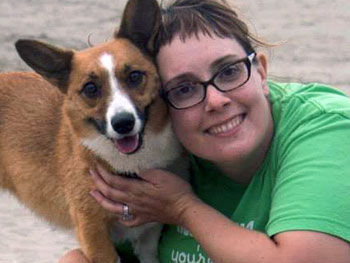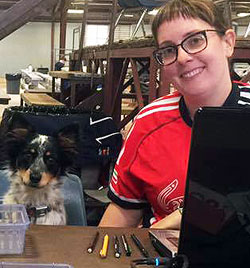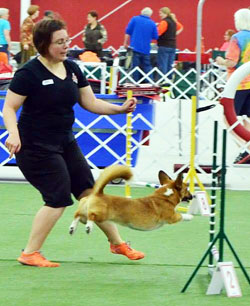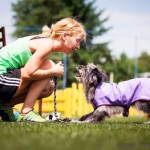What makes a USDAA judge?
Interview with Courtney Keys
At my first agility competition, it was a weird mix of fear and excitement. I only entered runs that I understood and only as many as I thought my dog and I could handle. I’d been trying to get to this place in time for a really long time. As I stood at the start line for the first time, all the anxiety melted away. I looked at my dog and felt we had already won. We had traveled a path to arrive at this point where nothing else mattered. I shared that space in time with my dog and one other person…THE JUDGE.
So I’ve wondered, who is that judge? What makes them want that job. What makes a ‘good’ judge? It looks like a hard job to me, standing all day, watching for flaws, subject to all sorts of criticisms. With those questions in mind I approached a favorite local judge, Courtney Keys.
Interview Questions & Answers
Hi Courtney, When did you begin competing in agility?

Courtney Keys & Fran
I began training in agility in May 2008. I think I probably entered my first trial later that year or early the next year.
I grew up riding and showing horses, like so many agility people did. I was 28 and hadn’t ridden regularly since college due to time and money constraints. I had dachshunds and did dachshund rescue, and knew of some other dachshund people doing agility. It looked so fun! I had two dachshunds at the time, and my Thor was 5 years old and had been through basic obedience classes and was clicker-trained by the time I finally signed up for an agility class
At what point did you become inspired to become a judge?
Thanks to a fantastic trainer and mentor I had while riding horses (Susan Horn of Prospering Farm), I already had some experience as a judge as local horse shows. She taught me how to judge and gave me the chance to do it. I am forever grateful for that. I really enjoyed judging horse shows, so when a Teacup Dogs Agility Association clinic was announced in Texas I didn’t hesitate to sign up. I think that was probably in 2010.
What steps did you take to make that happen?
Ah, well the TDAA clinic was my first step. It was a couple days of instruction on course design, and using the software, then actually building the courses and judging them at a real trial. My memories of that are faint! In 2012 I took and passed the USDAA Rules & Course Design Clinic at the Starters/Advanced level. Just last month in February 2016, I took that same USDAA clinic again and I’m now a Masters level judge for USDAA. I am also on the list of UKI judges and I have judged a few of those
What would you say is the most challenging aspect of judging and alternately, the most rewarding?
The most challenging aspect mentally is definitely course design. For a three-day trial I am probably designing 28-30 courses for USDAA Starters/Advanced or UKI. That’s a lot of courses!
The most challenging aspect physically is definitely being on your feet all day! I haven’t quite found the perfect solution for that yet though I keep buying lots of pairs of shoes to try.
The most rewarding is for sure seeing handlers and dogs have fun and success on my courses. You hear a lot of griping from people that things aren’t safe for the biggest dogs sometimes, but that’s who we ultimately are designing the courses for. I only have run small dogs, so when I see a big-striding dog jumping 26” having fun and easily navigating a course I’ve built, I love that.
When you are in the ring, what makes you laugh, and what makes you cringe?

Courtney and Walter
I do love the baby dogs in the ring. When they do something silly like come say hi to me or take a tunnel 6 times, you just can’t help but laugh. It’s also pretty amusing when a seasoned dog does something silly, too. Hopefully I am also laughing with the handler, as this sport is truly supposed to be a game we play for fun.
I hate to see people yelling at their dogs or blaming their dog in the ring or worse, dogs refusing to perform. You try to give everyone the benefit of the doubt, but some dogs don’t seem quite ready for competition yet.
What qualities do you think make a good judge?
Patience, confidence, creativity and humility.
How can a handler make the judges job easier?
By volunteering to work in the ring when you aren’t running!
You started a podcast. Can you tell us more about that?
It’s called Bitch Sprinkles! We currently have four episodes. We is me and my friend and coach, Emily Hurt. She’s an agility competitor and instructor in Dallas. We only get the chance to record when we see each other, which is sometimes often and sometimes not. Sometimes when we see each other it means we’ve spent 12 hours at an agility trial and neither of us want to record a podcast! But the idea for it came from all the time we spend together, especially in the car on long trips to shows. We thought people would enjoy being a fly on the wall, so to speak, for the agility-related topics we always discuss with each other. You can listen to the podcasts on iTunes or at our website, www.bitchsprinkles.com
What would you consider your biggest accomplishment to date in the agility ring?
My biggest accomplishment is the realization that everything that happens in there, good or bad, is entirely on my shoulders. It did take me a while to realize this! My dogs are all wonderful and they try their hardest for me, always. If I have an off course, or my dog drops a bar, I know that I did something to cause that, either with my handling or training or lack therof. And I also think realizing agility truly is a game is an important thing for me. I love to compete at big events and I LOVE to win things. But I also want to be true to my dog, plan a run that utilizes our strengths, and go for it out there. Outcome is irrelevant, truly. But, it is also really nice when everything comes together and you win a nice medal or ribbon too. I see people losing sight of the heart of agility, the partnership with their dog, when they are at a big event or trying to make a world team, and that truly hurts me. I like to be around the people who love and praise their dogs no matter what and I love to cheer those folks on too.
Do you think the sport of dog agility has changed through the years? if so, how?
I really haven’t been doing agility too long! So I’m not sure I’m qualified to answer, as I still feel very new to the sport myself. But what I’ve noticed is that the opportunities to compete at big events nationally and internationally have increased, and that’s changed our competitions here somewhat. We have the Masters Challenge classes in USDAA and the Premier classes in AKC that are supposed to be the highest level of competition, similar to what you’d see internationally. Those definitely weren’t around when I started.
What goals do you hope to achieve in competition, and as a judge?
 I try not to focus on outcome-oriented goals for competition, so I just want my current dog to have a blast every time she runs and I want my dog in training to do the same thing. We do always try to qualify for the USDAA Cynosport World Games, and we are almost fully qualified for 2016. If we make finals there, great; if not, as long as I’ve given my best effort I’ll still be happy.
I try not to focus on outcome-oriented goals for competition, so I just want my current dog to have a blast every time she runs and I want my dog in training to do the same thing. We do always try to qualify for the USDAA Cynosport World Games, and we are almost fully qualified for 2016. If we make finals there, great; if not, as long as I’ve given my best effort I’ll still be happy.
For judging my goal is to get some assignments at the Masters level and get released off supervision! When you first test or move up in level, you have to go through some weekends with a more experienced judge guiding you and making sure everything is going well. It can be hard to coordinate this and get assignments, so when I am fully approved at the Masters level I will be very happy.
What kinds of conflict can arise between the judge and handler and what would be the proper way to address those?
Thankfully, I’ve never had any real problems with this. I’m always open to people addressing any safety concerns they might see and to asking why I made a call the way I did and I’ve always been able to discuss those issues with the competitors and resolve them. There are many avenues available for me to address any misconduct on a handler’s part, but I thankfully have not had to make use of them yet!
What do you wish handlers knew with regard to judges and USDAA guidelines?
People complain sometimes that judges get so close to the contacts to judge them! Uh, but we have to be able to see them! Train don’t complain! 🙂
How do you feel judges might be able to support new competitors?
Judges need to be approachable and knowledgeable even at trials and events they aren’t judging. We are supposed to be a resource! I’m always happy to answer any questions or clarify a rule whether I’m judging or not.
If you had the ‘power’ what is one rule or standard that you would change for the benefit of the dog?
I’d lower the USDAA A-frame height.
How has being a judge affected you as a handler and trainer?
Being a judge helps me so much as a handler and trainer! You are the ultimate student when you stand out there all day. You are always learning. I’ve learned to identify challenges on courses that I run. And watching everyone else run all day really inspires me to train my own dogs, which is something I don’t do nearly enough.
What advice would you give people just starting to compete at agility trials?
Don’t be scared. No one is watching you. Don’t be afraid to ask questions! You learn a lot by just watching and even more by volunteering to work in the ring. Learning the rules and how things are scored will make it easier to succeed (the rules are all published online and available to everyone). Complimenting someone else is the easiest way to make a friend. Your dog is always right and he tries so hard for you, so give him lots of cookies and praise!
Find ou more about Courtney at www.courtneypo.com and www.bitchsprinkles.com


